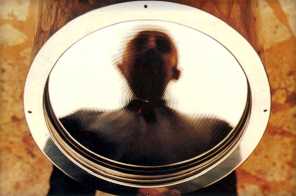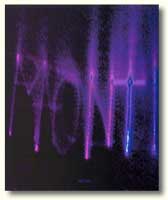|
A Note on Paolo Monti’s Work
Ervin Laszlo, President of the Club of Budapest
 |
Paolo Monti is that remarkable artist who conveys the insights gained in the
latest theories of the natural sciences in his artistic work. He goes beyond
mere pictorial representation, to a dynamic concept of observer and observed;
man and universe.
This is entirely in line with the vision that is currently
emerging at the leading edge of the sciences. |
The vision emerging in the
sciences is a source of meaning for our lives and orientation for our hopes and
expectations. How we relate to each other and to nature depends not only the
accidents of our upbringing and daily encounters, but also on our basic concepts
of nature, of live, and of the thinking and feeling human being. Whether we know
it or not, these concepts are subtly influenced by what we know of the world
picture projected by the sciences. If we believe that nature is a lifeless
mechanism, a collection of passive rocks, we will come to believe that we are
entitled to do with it as we please, so long as we do not go against our
interests. Our choice of technologies will reflect these beliefs: we shall opt
for powerful machines to extract, transform, use, and discard the energies and
materials found in our environment. If we look on animals and other people as
but more complex machines, we shall manipulate them, too: we will cut out their disfunctioning parts and organs, splice up their genes, or rewire the
circuitries of their brain. We shall also manipulate people’s social and
political behaviour, their labour, even their lifestyles, consumption patterns
and leisure-time activities.
Yet the current wave of change sweeping through the natural sciences leaves
behind the last remnants of the mechanistic view of life, mind and universe.
Space and time are united as the dynamic background of the observable universe;
matter is vanishing as a fundamental feature of reality, retreating before
energy; and continuous fields are replacing discrete particles as the basic
elements of an energy-bathed cosmos. And the final destiny of this world is no
longer a lapse into the greyness of a lukewarm, empty and eternally unchanging
nothingness, but could well be cyclic self-renewal in a self-creating,
self-energizing, and self-organizing mega-universe.
Nature -the universe itself- is not a passive rock or a lifeless machine. People
are not complex machines, and not separate from each other and from their
environment but profoundly though subtly linked. The entire cosmos throbs with
the creative energy of self-organization, constantly evolving, with periodic
bursts of explosive innovation. And everything we behold enters into subtle but
constant interaction with us, the beholders. If this would be the concept of man
and universe we entertain, we would not relate to each other and to our
environment in the mechanistic and thoughtless way we do today.
The concept of a subtly interconnected world in and through which we are
intimately linked-to each other and to the universe, assimilated by our
intellect and embraced by our heart, may be part of humanity’s response to the
challenges that we now face in common. Art has an important role in articulating
this response through its own aesthetic medium. We must be grateful to Paolo
Monti for showing us, through his art, that we are part of the world around us,
part of an ever-changing reality that may be kaleidoscopic on the surface, but
has meaning and significance on a deeper, more scientifically informed or
aesthetically intuitive and sophisticated level.
 Ervin Laszlo, founder of Club of Budapest, was born in Budapest in 1932.
He is a member of Club of Rome, the International Academy of Science, scientific
consultant to UNESCO, rector of the Academy of Vienna. He is a philosopher,
scientist, pianist and author of more than 50 books. He has lectured at numerous
universities including Yale, Princeton and the New York State University. Ervin Laszlo, founder of Club of Budapest, was born in Budapest in 1932.
He is a member of Club of Rome, the International Academy of Science, scientific
consultant to UNESCO, rector of the Academy of Vienna. He is a philosopher,
scientist, pianist and author of more than 50 books. He has lectured at numerous
universities including Yale, Princeton and the New York State University.
"A
Note on Paolo Monti’s Work" by Ervin Laszlo
was first published in Paolo Monti (MUSIS, 1998) : ISBN
88-87054-01-0 and presented in the collection of selected
texts produced for the personal exhibition of Paolo Monti,
Vierdimensional², Konstanz (Germany), 2001.
|